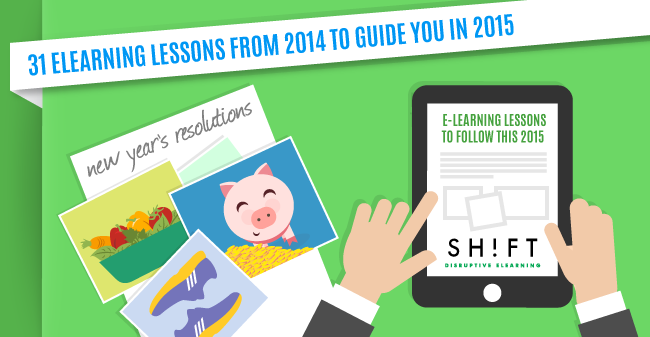The year is about to end, and people around seem to have gone into a nostalgic mood. Websites are fondly remembering what took place in the year gone by—trends that ruled the ramp, blockbusters that broke box-office records, and men, women, and events that made an impact. Year-end seems to be the ideal time for reflection and recapitulation. So why don't we?
As eLearning professionals, we learned many important lessons in 2014. Let's take stock of these:

1) Back your courses with hard science.
If you want to create effective learning, you have to teach in a way that the brain learns best. Thankfully, scientists have decoded how we learn. The following seven points look at key principles from neuroscience research paired with tips that will allow you to achieve effective eLearning development.
2) Less us, more them.
Be a learner's designer and create learner-centric courses. Step into the shoes of your learners, think like them, and figure out how you can help them before you head out to the drawing board. Don't ever attempt to design without having a deep, intimate knowledge of who you're designing for.
3) Delve into the psyche of your learners.
Effective eLearning courses resonate with learners and talk to their hearts. Because people think differently than you, psychology must guide your eLearning design decisions — not intuition. Use a dose of psychology to understand how your learners can learn most effectively.
4) Get real.
To create value for your corporate learners, ditch the airy-fairy stuff in your courses. Motivate and engage your learners by creating a course that provides ample takeaways and contains "real" teach they can apply at their workplaces. After all, a course is only considered valuable if you get to apply what you have learned.
5) Simplicity makes sense.
Do not overwhelm your learners with cluttered screens. They should be able to concentrate on their learning instead of hunting around for information. Simple designs soothe the eye and do not tax the brain.
6) Be the problem solver.
It's not just about developing good taste or applying aesthetic principles. eLearning design is mainly a job of solving problems. It's about making someone else's life easier by helping them acquire knowledge or get skilled. Besides, you design courses for busy and application-oriented corporate learners. So ditch the fluff however pretty it might be; instead, provide value to the learners by solving their problems or empowering them to do so. Being problem- focused should be the starting point for all design efforts.
7) Focus on learning outcomes.
Do not cut corners. Go the extra mile to determine the exact learning outcomes that map to learner expectations and life situations, and then go all out to fulfill these goals through your course. Focus on how effectively you can transfer knowledge and skills, so the learners can truly benefit from the course.
8) Don't begin an eLearning course without a clear path in mind.
Start with why.Your learners are purpose-driven individuals. So the courses you design should have a definite end to motivate them. Set the right goals to create courses with enduring values. Ask the right questions before you get down to storyboarding.
9) Space out.
More is not usually merrier because human beings can focus only for a short span after which attention and concentration begin to wane. In contrast to crammed learning, spaced learning takes place over an extended period of time. The latter is definitely superior to crammed learning because the brain needs ample time to take in and fully understand new facts before it can accept the next group of information. Bottom-line: Space out and don’t have all the learning condensed into one sitting.
10) Show empathy.
Put yourself in the shoes of your learners and empathize with his situation, needs, and aspirations. When you create your course, always think from the perspective of the learner. Ask yourself, "Why would I want to take this course?" After you have finished developing the course, review it while you ask yourself, "Do I want to take this course?"
11) Design matters.
In eLearning, the aesthetic quality of a course can improve the learning outcomes. Content matters as well, but the beauty of the course shouldn't be underestimated. Tap into the power of visuals to create eLearning courses that stick.
12) But be careful, looks are only skin-deep.
Although a good-looking course is a treat for the eyes, do not be obsessed with visual design. After all, the effectiveness of anything is determined by its functionality.
13) Content and design go hand-in-hand.
The most effective eLearning course effortlessly blends content and design. Content and design complement each other. An effective design helps learners navigate to the content, which, of course, has to be relevant.
14) Beware of design overkill and information overload.
The human brain can process and remember only so much information at a time. Facilitate learning by using multiple channels of instruction, but don't force learners to parallel process. Beware of design overkill.
15) Think beyond just visuals to grab learner attention.
Although visuals are powerful learning tools, your course shouldn't rely only on flashy graphics and bold colors. Even videos will fail to make an impact if the content is not compelling and cannot bring about engagement in learners.
16) Content should be interesting and engaging no matter the medium.
Create content that engages and excites learners. Otherwise you cannot keep them hooked till the end. It should be the content on the computer that is compelling, not the fact that it is on a computer.
17) Engagement is driven by emotional connection.
Human beings are driven by emotions. To achieve true learner engagement there needs to be an emotional connection between the content and the learner. Make your learners connect emotionally with the course. This post will help you understand this thoroughly and even learn how to apply it to your eLearning.
18) Tell stories to connect emotionally with your learners.
We are moved by stories that touch our hearts and resonate with our realities. In fact, stories inspire us to action more than dry facts, jargons, and impersonal visuals.
19) Create a lasting first impression.
A great way to engage learners is to hook them early on, so they can't wait to take your course. Create a lasting first impression with ploys like telling a story or using compelling visuals to set the mood.
20) Embrace every opportunity to make a boring and technically complex course interesting.
Teaching complex and dull technical content is always a challenge for instructional designers. You have to keep the audience engaged and at the same time, help them learn effectively by simplifying information and using diverse media to explain content.
21) Short eLearning courses are better!
The human brain can maintain focus for short durations, so we learn best when content is presented in small chunks.
22) Create intuitive designs.
Don't make life difficult for learners by making them try hard to figure out how to navigate the course. Create an intuitive user interface where navigating is smooth sailing.
23) Create courses that learners feel motivated to take.
Learning occurs spontaneously and effortlessly when learners feel motivated to take the course. Design your course to spur motivation.
24) Motivate learners by including "aha" moments in the course.
Use more than one trick to keep learners motivated. Structure your course so that the goals are evident and the learners gain insights they can take back to their real worlds.
25) Don’t try to dazzle with technology.
We have a plethora of tools and technologies to create eLearning courses that bring out the "wows." But the course will fall flat on its face if the content fails to motivate or engage. Do not focus on technology at the cost of compelling content.
26) Don't let technological considerations dictate the instructional strategy.
Do not let technological considerations or constraints drive your choice of an instructional strategy. Your mission is to create value for your corporate learners. So your instructional strategy should be centered on factors like corporate objectives, learning outcomes, prior knowledge of the learners, and elements of corporate culture that may influence learning performance.
27) Effective communication is key.
Well-design courses are worthless if they can't communicate content effectively to those learning. It is no use designing a stunner if your course cannot fulfill the objectives it had set out to achieve. The content you design, above everything else, should communicate the instructional message effectively .
28) Learning is effective only if it can alter behavior to elicit enhanced performance.
And yes, eLearning courses have the power to persuade and modify thought and behavioral patterns. The trick is to connect emotionally with the audience and appeal to their hearts without of course, abandoning logic. Create a memorable experience.
29) Learning is a social phenomenon.
Human beings are social animals. We function more effectively if our societal needs are fulfilled. We learn best when we can interact with our environments and within a social setting. Learning is most effective in environments that fulfill these social needs.
30) Don't be shy to ask for help.
No man is an island entire of itself. This quote by a great poet sums up the essence of human existence—we are all connected. Don't expect to become a master of eLearning design overnight. You will need to ponder on your lessons and look for new insights. Ask for help; there are plenty of free tutorials out there.
31) Always keep learning.
As research in Neuroscience and Cognitive Psychology continues, more and more insights into how we learn will be gleaned. So you will have to keep up with your knowledge, so your learners can have the benefit of your insights.
CONCLUSION:
The lessons we learned in the past year are in no danger of becoming obsolete soon. Carry these lessons into 2015; these takeaways will help you evolve as an instructional designer who can change lives for the better.








